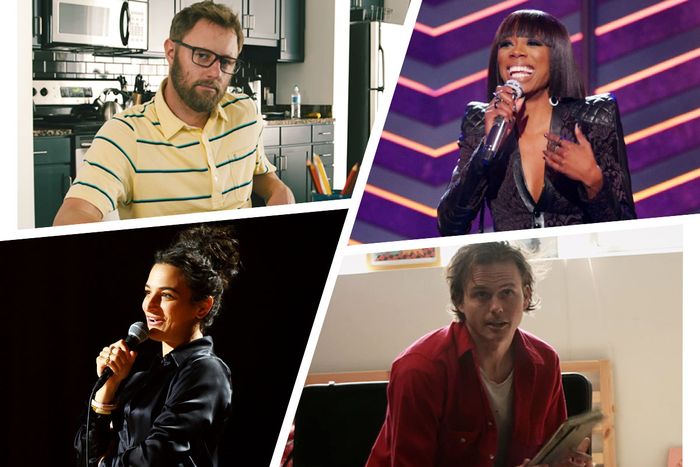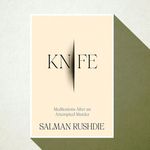
In her 2020 HBO comedy special Momma, I Made It, Yvonne Orji stands on the stage in front of a large and appreciative audience in Washington, D.C., telling jokes about her life. She is a confident, charismatic performer who can slip in and out of the characters she creates onstage so that she is with them, against them, laughing at them, illuminating them, all in the course of the same story. When Orji, who is Nigerian American, tells a joke about haggling at a Lagos market, she is three characters at once: the shopper pushing for the lowest price, the insulted seller, and Yvonne Orji the narrator, laughing at all of it.
Then the scene cuts, and now the camera is following Orji as she and a friend wander past market stalls in Lagos, looking at fabrics and haggling over the prices. “See?” this scene seems to say. “It’s just like she said!” This kind of footage returns throughout the special, woven in between scenes of Orji’s stand-up performance. Here’s a talking-head interview with her parents, teasing her material about parental expectations. Here’s a scene where she asks for directions, right after a riff on how Nigerians can’t give directions.
As a record of a live performance, the comedy special is not all that different from a band’s concert documentary. The backstage framing device has been a familiar gambit for decades, that fun little sequence before the show starts as we watch a comedian coming in through the stage door. But Orji’s Momma, I Made It is one of a distinct new wave of specials — call them docucomedy — that’s taken shape in the last couple years. There was Gary Gulman’s The Great Depresh, Jenny Slate’s Stage Fright, and Craig Ferguson’s six-part series, Hobo Fabulous, all from 2019; Whitmer Thomas’s The Golden One in 2020; and, this year, new specials from Chris Gethard and Rory Scovel. In each of these, documentary scenes are spliced with scenes of a filmed comedy performance. The documentary elements are not designed to stand on their own; they’re more like recurring bonus scenes, punctuating and ornamenting a comedian’s material.
The rise of these docucomedy specials is — and I don’t mean to put too fine a point on it, but at some point I have to say it — bad. They play on a desire to see comedians as truth-tellers and authentic personalities and feed into the idea that good comedy stems from a performer’s authentic self. They underline the expectation and value of personal access. They position comedy specials in the same push for prestige aesthetics happening elsewhere in TV and on streaming platforms, surfing on the assumption that documentaries are a higher art. Maybe most frustrating is that documentary footage rarely makes a comedy special funnier. You may know the comedian better now, but that doesn’t mean you laughed more.
Stand-up comedy is ripe for the uneasy, false collapse of the personal and the performance. Aside from the stage itself, often dressed to be as casual as possible, there are few overt cues that signal stand-up as a mediated experience, a choreographed production rather than just an hour with a person being funny. At best, it can feel like the comedian’s giving you total access to their worldview; that funny anecdote may not actually be true but retains the feeling of truth because of how well they tell it, how fully it resonates with the crowd. As comedy has shifted from the high-key formal nakedness of a setup–punch-line structure and toward the realism of loose-seeming personal anecdotes, the veneer between performance and self has grown vanishingly thin. Never mind that the “My friend told me the other day” style of joke setup is still a form of fabrication. Shaping any event or thought or premise into narrative is always a translation, always the imposition of a system of priorities that warps reality to make it art.
Complicating this is the fact that offstage personal moments have become their own kind of performance online; now that an audience can follow a comedian’s “real” life on social platforms, jokes that seem truer and more confessional, jokes that reflect those personal narratives, also start to seem better. And in docucomedy, filmmakers are eager to show receipts. In Slate’s Stage Fright, material about her grandmothers cuts to footage of those same grandmothers, forcing Slate’s onstage impressions into direct comparison with the real people. In Thomas’s very personal hour about his childhood and his mother, the documentary elements—which show Thomas hanging out with his family and asking them what they remember about his mom—become a shortcut, bypassing Thomas’s work in favor of a blunt visual record. It’s an attempt to give the audience some of the same closeness Thomas has to the subject, but it unbalances the production.
Even in Gethard and Scovel’s specials from 2021, which are more in the tradition of the tour-special documentaries from 20 or so years ago, the documentary parts feel like they’re being held up as a kind of evidence. When we see Gethard describing the vibe of a venue or hanging out with his infant son, or Scovel doing postgame analysis of a show on the way home, the filmmakers seem anxious to prove that the person doing the work is, in fact, a regular goofy person. The operating premise is that if an audience likes a comedian onstage, surely they’ll like that comedian even more if they get more of them, more authenticity, more intimacy. And yet puncturing the onstage authenticity with documentary footage just re-creates the same illusion, swapping one constructed reality on the stage for another constructed reality filmed in a hotel room or on the street and edited to look naturalistic.
All of that aside, a show interlaced with documentary elements cannot help but be exactly that: a comedy special where the comedy is always getting interrupted by something else. In Momma, I Made It, the Nigerian documentary material in part helps introduce an American audience to a Nigerian culture that may well be unfamiliar. But while that impulse is certainly understandable, the need for it is regrettable. Orji onstage is so buoyant, so magnetic. So much of the skill and pleasure of an hour of live material is in watching how a comedian builds it and how they negotiate its awkward transitions, lampshading or highlighting or making a meal of them. In docucomedy, the documentary scenes, plunked in at opportune intervals, become a blunt way to staple all the seams together. There is less time to breathe between sections of material, less time to react to what was said. Those documentary insertions rob us of the opportunity to see the full extent of Orji’s greatness. An hour of comedy is a mountain to climb. It’s a feat. The comedian has to hold a room’s attention, and some of the most incredible performers demonstrate their skill and confidence through their ability to let the entire room get still for a few moments without frantically scrambling to fill the silence. Great comedy maintains its own internal pressures and releases. Documentary insertions disrupt that flow; they are too-easy relief valves.
There are ways to make this kind of hybrid form work. Cinematography and direction can make a performance feel special—loved, beautiful, worried over—without falling into the “See, it’s so real” mode. My favorite recent example is Lil Rel Howery’s 2019 special, Live in Crenshaw, which places Howery in a high-school gymnasium in L.A. and films him surrounded by an audience so that their reactions are an inherent part of the experience, and the setting is a defining element of the special’s visual texture. You could also look to Bo Burnham’s and Jerrod Carmichael’s projects, or a more traditional but beautifully made special like Nikki Glaser’s Bangin’, where the camera moves into the audience, showing us the back of an audience member’s head as it shakes in laughter. Or if there must be documentary content as part of a comedy special, it should be as well considered and indispensable to the project as it is in Gary Gulman’s 2019 special, The Great Depresh.
The Great Depresh, which is about Gulman’s personal experience with depression, does use documentary footage in a way that, intentionally or not, positions the special as a prestige project. It still interrupts the experience of watching Gulman onstage. The difference, though, is that the documentary elements are not there to reinforce Gulman’s points. The Great Depresh plays with the idea that “the truth” of a person is always some version of public performance, and the documentary footage is a necessary illustration of the things Gulman sees about himself and others don’t. The special opens with footage of the comedian at an unbearable low point, and yet, somehow, he is sitting on a stool onstage, working on material. The documentary shows us something Gulman cannot articulate with the same force onstage, something much less literal than an impression of a grandmother followed by footage of the grandmother. He wants his audience to understand the gap between his cheerful, confident stage presence and what it actually feels like inside his brain, enacting that split between internal and external in a way they can experience.
As documentary material has boomed on TV and on streaming platforms, a specific style has become synonymous with importance. Shaky cameras and fly-on-the-wall observational footage, overlapping audio and scenes that include people settling into their interviews in a way that reveals the mechanisms of the production: This is how we know a project is supposed to be “serious” rather than cheap. It’s frustrating to see the creators of these specials slotting comedy into that same category, a superficial appeal to artfulness that rarely feels inherent. Although, right now, docucomedy mostly feels like a step backward for the comedy special as an art form, the hope is that more comedians will insist on using the form intentionally or, even better, playfully. Imagine the subversive delight of documentary footage that suggests everything someone’s just said onstage is totally false, or a special where the onstage performer asks their live audience to engage with documentary elements.
Anyone engaged with the Great John Mulaney Conversations of 2021 is already familiar with the idea of the parasocial, the way audiences build relationships with celebrities or characters without ever actually interacting with them beyond the consumption of their public selves. There’s nothing wrong with parasocial relationships. But when a special is peppered with footage that’s meant to give audiences access to a more “real” version, the implication is that the parasocial relationship we have with the comedian—that we understand who they “truly” are—matters as much or more than the performance. It twists the priority of making art: Rather than being the artistic lie that reveals the truth, comedy becomes the thing you wait through in order to get to the “realer” thing.
Listen to Kathryn VanArendonk discuss docucomedy specials with Jesse David Fox in the below episode of Vulture’s Good One podcast:





